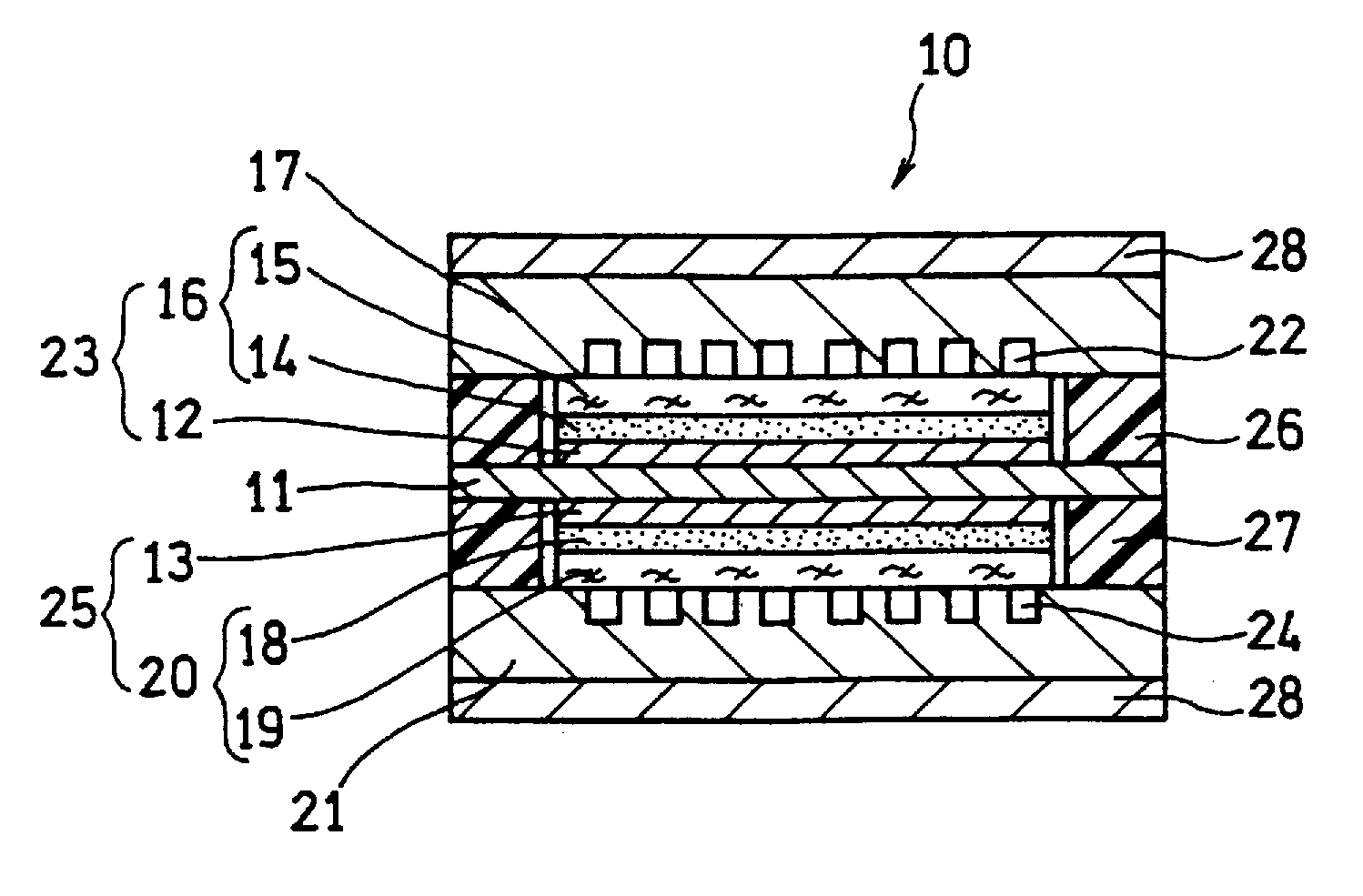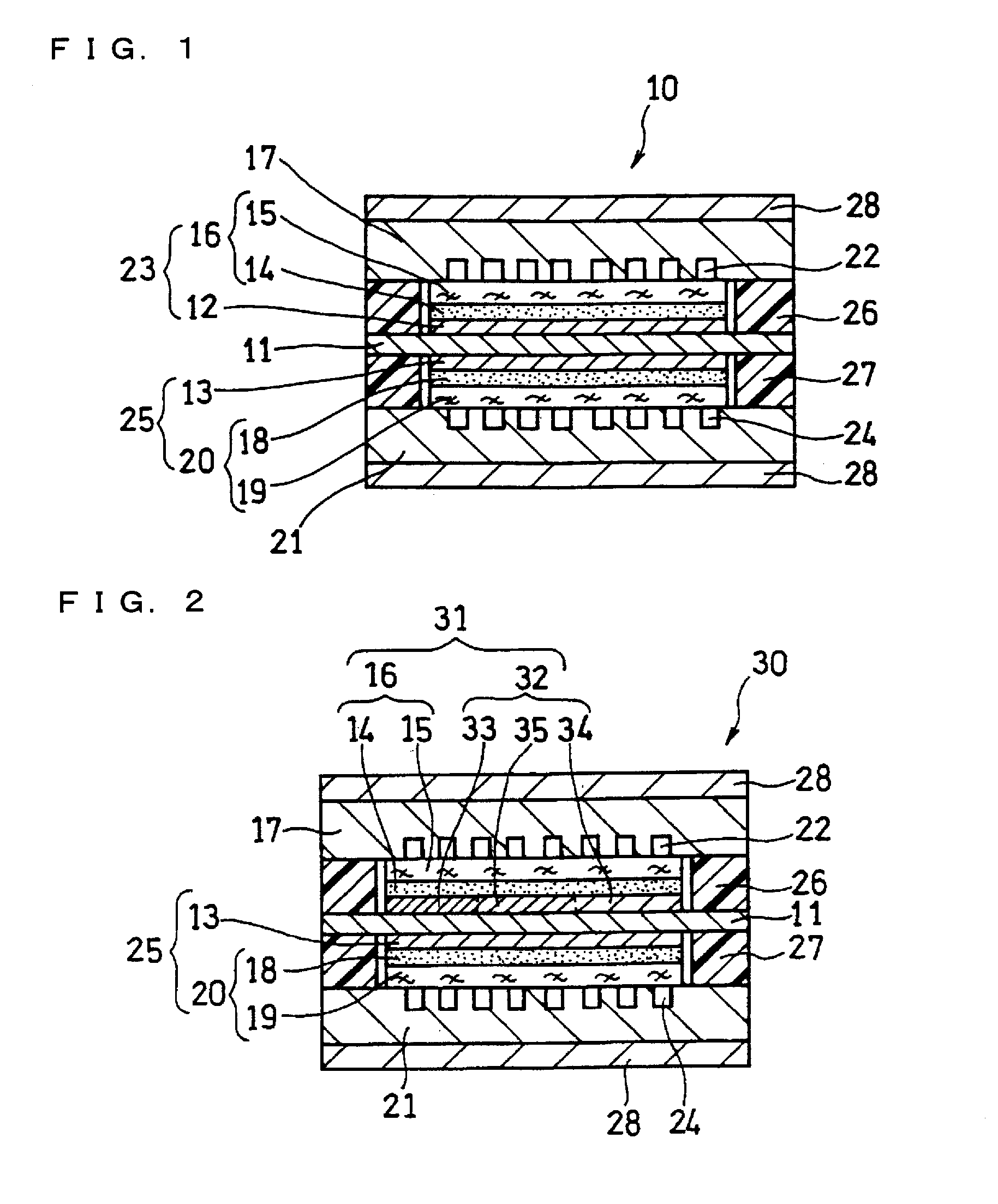Direct oxidation fuel cell
a fuel cell and direct oxidation technology, applied in the direction of fuel cells, fuel cells, solid electrolyte fuel cells, etc., can solve the problems of reducing power generation efficiency, lowering voltage, and dmfcs currently have to be solved, so as to achieve better understanding, reduce the effect of fuel crossover and better understanding
- Summary
- Abstract
- Description
- Claims
- Application Information
AI Technical Summary
Benefits of technology
Problems solved by technology
Method used
Image
Examples
example 1
[0129]In this example, a fuel cell as illustrated in FIG. 2 and FIG. 3 was produced.
[0130]A supported anode catalyst comprising anode catalyst particles supported on a support was prepared. A platinum (Pt)-ruthenium (Ru) alloy (atomic ratio 1:1) (average particle size: 5 nm) was used as the anode catalyst particles. Conductive carbon particles with an average primary particle size of 30 nm were used as the support. The ratio of the mass of the Pt—Ru alloy to the total mass of the Pt—Ru alloy and the conductive carbon particles was set to 80 mass %.
[0131]A supported cathode catalyst comprising cathode catalyst particles supported on a support was prepared. Platinum (average particle size: 3 nm) was used as the cathode catalyst particles. Conductive carbon particles with an average primary particle size of 30 nm were used as the support. The ratio of the mass of platinum to the total mass of platinum and the conductive carbon particles was set to 80 mass %.
[0132]A 50 μm-thick fluorine...
example 2
[0157]In this example, the loading densities of the anode catalyst particles in the respective regions of the anode catalyst layer were changed by adding a pore-forming agent to the anode-catalyst-layer forming ink and changing the amount of the pore-forming agent. In this example, lithium carbonate was used as the pore-forming agent.
[0158]Specifically, in the same manner as in Example 1, the anode catalyst layer was composed of three regions of a first region, a third region, and a second region. The size of each region was set to 20 mm×60 mm.
[0159]A first ink for forming the first region was prepared by mixing 2 g of lithium carbonate per 80 g of the anode-catalyst-layer forming ink used in Example 1 and dispersing it.
[0160]A third ink for forming the third region was prepared by mixing 5 g of lithium carbonate per 80 g of the anode-catalyst-layer forming ink used in Example 1 and dispersing it.
[0161]A second ink for forming the second region was prepared by mixing 10 g of lithium...
example 3
[0169]In this example, the loading density of the anode catalyst particles was changed by changing the support ratio of the anode catalyst particles supported on the support. The support ratio represents the mass ratio of the anode catalyst particles to the total mass of the anode catalyst particles (Pt—Ru alloy) and the support.
[0170]In this example, a Pt—Ru alloy (atomic ratio 1:1) was used as the anode catalyst particles in the same manner as in Example 1. Conductive carbon particles with an average primary particle size of 30 nm were used as the support.
[0171]Also, the anode catalyst layer was composed of three regions of a first region, a third region, and a second region. The size of each region was set to 20 mm×60 mm.
[0172]The support ratio of the anode catalyst particles of the supported anode catalyst (first supported catalyst) contained in the first region was set to 80%. The first region was produced in the same manner as the preparation method of the first region of Exam...
PUM
| Property | Measurement | Unit |
|---|---|---|
| loading density | aaaaa | aaaaa |
| loading density | aaaaa | aaaaa |
| particle size | aaaaa | aaaaa |
Abstract
Description
Claims
Application Information
 Login to View More
Login to View More - R&D
- Intellectual Property
- Life Sciences
- Materials
- Tech Scout
- Unparalleled Data Quality
- Higher Quality Content
- 60% Fewer Hallucinations
Browse by: Latest US Patents, China's latest patents, Technical Efficacy Thesaurus, Application Domain, Technology Topic, Popular Technical Reports.
© 2025 PatSnap. All rights reserved.Legal|Privacy policy|Modern Slavery Act Transparency Statement|Sitemap|About US| Contact US: help@patsnap.com



